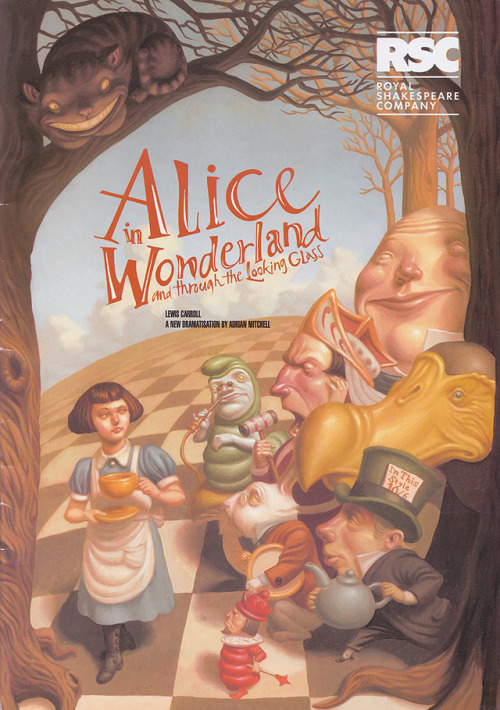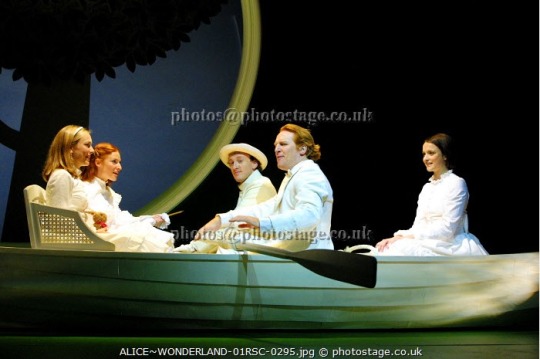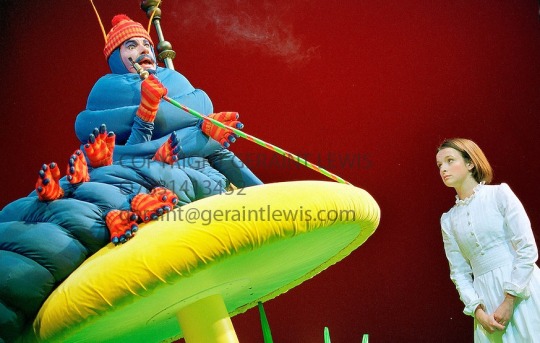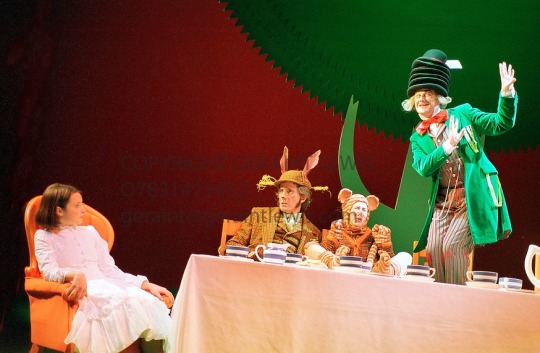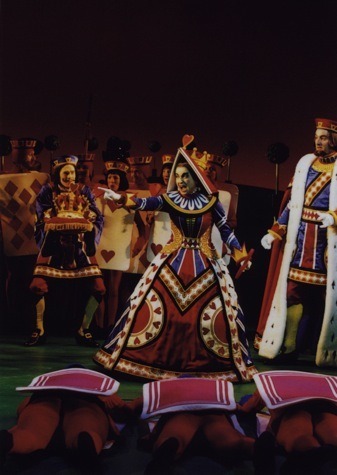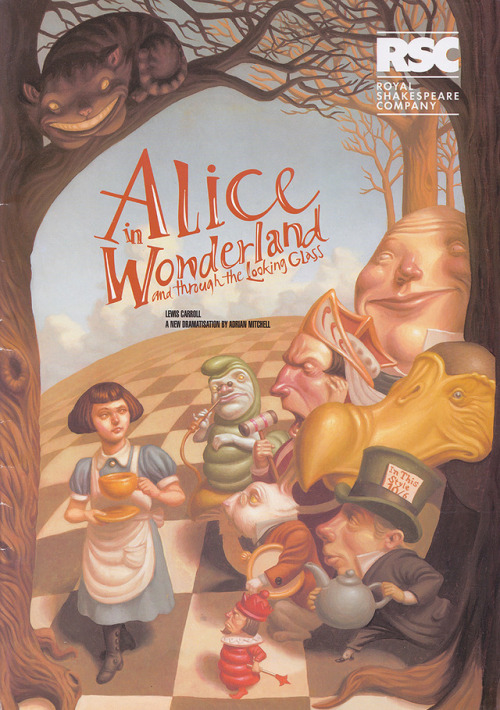
NOTE: This review uses photos from Photostage and Zuleika Henry, complete with watermarks. Please note that I cannot remove the watermarks as these are private property, and the photos belong to the owners. No copywrite infringement is intended.
(EDIT: As of 2025, I can say, I've read other play adaptations of Alice and this is by FAR the best one. Hands down, nothing comes close. I'm not sure why I didn't love this 100 percent on first read or watch. You can take that 4 star I gave this up to a 5 now. No, it REALLY is that good. Here's the licencing link worldwide. Yes, you CAN perform this in any theatre environment you want!)
With many thanks to @silvesterbotticelli.
A SMALL INTRODUCTORY NOTE
This review is of a non-commercial recording of the 2001 cast which is held in a private collection.The Original cast has its own successes and failings, and there are many differences between this production and that which is described in the published script. I will address the issues of the published script in the review, and I will also judge this production on its own merits.
CHILD OF THE PURE UNCLOUDED BROW, WITH DREAMING EYES OF WONDER…
The prologue to act 2 opens in the same space the epilogue to act 1 left us in, Alice’s drawing-room. Lorina attempts to teach 6 year old Edith chess, but both get into an argument and Edith walks off. Alice is not interested in the game as she never seems to win and is more focused on talking with Kitty, the black kitten. Infuriated Lorina soon leaves, Afred Lord Tennyson book in hand.
LOOKING GLASS WORLD
As the room goes dark, and Alice grows tired, she is drawn to the looking-Glass whilst the Company sing of magic. “Moonlight on the Mirror” is one of the best songs in the entire play, with Terry Davies and Steven Warbeck’s arrangements conveying a sense of wonderfulness. I actually can’t imagine what this song would sound like minus this arrangement…
Alice climbs through to Looking-Glass House which in this production is just a gigantic mirror on a mantelpiece. The chess piece scene rolls round quickly and Jabberwocky for some bizarre reason is recited by father William and Son. Who aren’t in this book. Which leads me to question why Mitchell as an adaptor made this choice. The garden of live flowers is also disappointing as it consists of one flower, Tiger-Lily. Why the others couldn’t be included is a mystery.
Much better is the Red Queen, played by Liza Sadovy, who truly is the essence of all governesses! The running scene is done incredibly well and I cannot work out how it was done. Treadmill maybe?? Left alone Alice endures a strange train ride.. which ends too quickly. Paul Lenard, Mark McLean and Mitchell Morero all make fine train passengers and the scene is delightfully frantic, only to stop suddenly as in this version Alice reaches the end of the line and has to walk the rest of the way. The Gnat is also absent, as are the Looking-Glass insects.
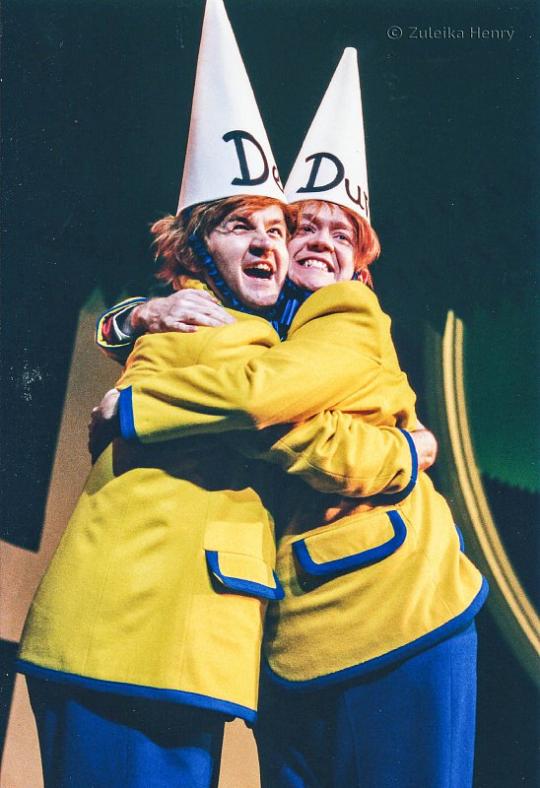
Dum and Dee are however wonderfully obnoxious and are played with gusto by Jamie Golding and Adam Sims. Also this scene features one of the best theatrical versions of “The Walrus and the Carpenter” I’ve ever seen. It even incorporates Carroll’s rewritten lyrics for the first Alice stage adaptation! Think of the way it was portrayed in 1999 and you aren’t far off!
Marilyn Cutts makes for an excellently eccentric White Queen, and a weird sheep. The published script puts the Cheshire Cat in the shop scene (I know. Why??) but this production thankfully removes this!
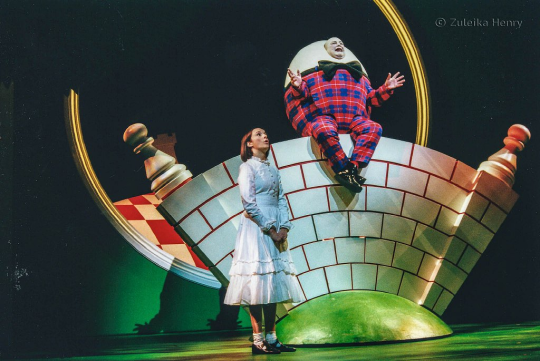
I did not care much for Martyn Ellis’s Humpty Dumpty, he seemed to be using the same technique the Gryphon used in the Wonderland adaptation- screaming out the lines as loud as he could! The orchestration of “In Winter When the Fields are White.. “ is also an utter disappointment. You often can’t hear the lines!
The White King was very unmemorable as played by John Condroy. I’m actually struggling to remember his performance as I write this…
The Lion and the Unicorn was a fantastic great big set piece, with the Company cheering for either side. It is set up like a sort of boxing match, and Mark McLean's Lion has more than a hint of a certain London boxer in his characterisation. If it is what the director was going for, its a little bit odd as it has no relation to the Victorian era. The Unicorn is extremely Scottish, with a very thick accent. The Company song “The Lion and the Unicorn” is an ensemble piece, with all including Alice joining in. Its a fun but too short number.
Things take a more delicate and melancholic tone after the White Knight (played by the same actor who played Dodgson) rescues Alice from the Red Knight (bizarrely this production has him played by the same actor who played Duckworth) Although there are plenty of laughs in this scene, Daniel Flynn’s White Knight plays up the melancholy. This reaches its peak in a beautiful and funny take on “A sitting On A Gate”. One of the few times this show takes a more specious pause for breath.
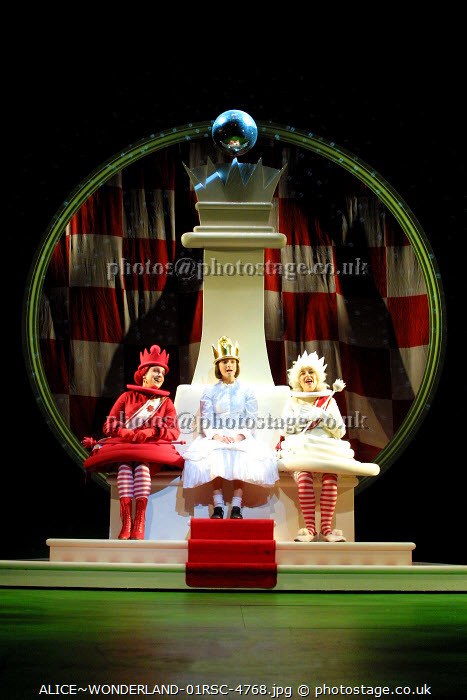
“Welcome Queen Alice” is sung in a wonderful arrangement by the Company as the White Rabbit (yes, I know) gives Alice her chess crown. In this version there is no proper feast to speak of (the food scene doesn't occur) instead Alice climbs up a gigantic chess piece chair to sit alongside the Red and White Queens. The official Queen examination scene is delightfully funny but feels too rushed. That’s because the White Queen announces “Something is going to happen!” and it does. The Jabberwock descends on to the crowd, scattering everyone. As soon as everyone vanishes, Alice sees the looking glass and passes through.
Awakening at home on the hearthrug in the drawing-room with the Black Kitten and Snowdrop in her hands, Alice ponders the meaning of her dream. Was it hers or the Red King’s?
If I were to be brutally honest, I much prefer Carroll’s feast scene to this. It doesn’t really work as a denouement, I also feel like there was no threat to the Jabberwock because as an audience we barely see it (this production only shows its red eyes!) As a result, Alice’s awakening does not feel significant or pronounced the way it is in the book. It just.. kind of happens. I will give this version immense credit for actually showing us Alice pondering the Red King dream question at the end. Many versions leave this out.
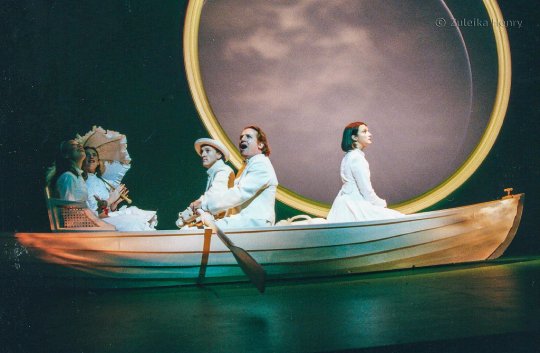
A BOAT BENEATH A SUNNY SKY…
Back on the riverbank Dodgson finishes his tales (yes this version implies he told both stories in one day. Poetic licence!) Dodgson, the Liddells and Duckworth row home, but Alice Liddell feels affected by what she has heard. Before they row off, she asks Mr Dodgson to “write down Alice’s adventures”.
As they row off singing a reprise of “All in the Golden Afternoon…”, fictional Alice stands onstage and seems to hear echoes from her adventures in Wonderland and Looking-Glass World. The lights begin to fade, until all we can see is her.
CONCLUSION
Overall I found this 2001 recording 100 times better than the published script. I give this particular staging a 4 out of 5, with an added note to be cautious with the published script, as it leaves plenty to be desired.
No doubt the best thing about this adaptation was Katherine Heath’s performances as Alice Liddell and “Alice”. Heath made an eager Alice Liddell and an intelligent, quiet and polite “Alice”. This production also has stellar set design and a formidable cast, some playing up to 4 parts!
Although some of the scenes are rushed, it flows much better than the published script and this recording has my highest recommendation if you wish to see a dramatisation of both books in full!
